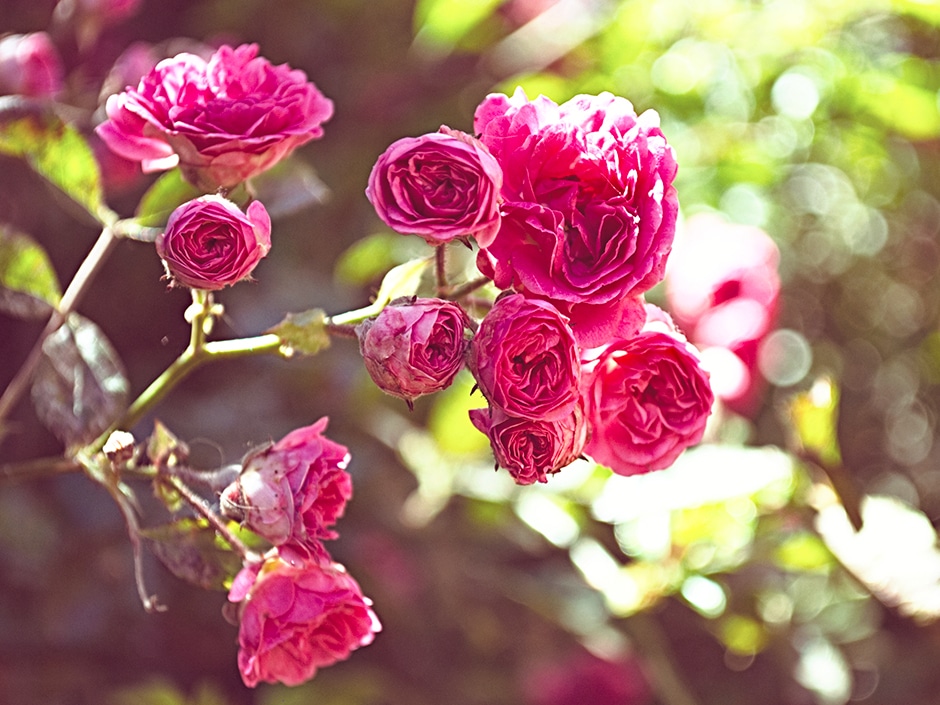The ultimate guide to growing roses at home
DIY and how-to

HOW TO GROW ROSES AT HOME
From classic bush varieties to climbing or ground-cover roses, there really is a rose for every situation, part of the garden or garden style. Our garden experts share guidelines and some top tips to ensure your roses flourish and flower all the way from spring until autumn.
PREPARING A BED FOR PLANTING ROSES
When preparing a bed for your roses, it’s best to prepare an entire bed rather than digging individual holes, as this will enable the roots to spread out easily.
Here’s how to prepare the perfect bed for your roses in 5 steps:
- Find a bed in an open, sunny position, which allows you to space your roses far enough apart to ensure good airflow. This will help to guard against fungal diseases like black spot, mildew and rust.
- Before planting your new roses, place them in their bags in the desired position. This will give you the chance to see how the colour combinations work and whether they are receiving enough space and light.
- Dig a large square hole of 1m x 1m for each rose bush. If you plant roses in containers, make sure they have a diameter of at least 35cm and add plenty of moisture-retaining granules to the potting soil.
- Add one bucket of pine-bark chips and one bucket of compost to every bucket of garden soil taken from the hole. Place superphosphates or bonemeal at the bottom of each hole.
- Line the sides of the holes with cardboard from old wine boxes when planting roses near shrubs or trees with invasive roots to keep out the roots and hold the moisture in the soil.
Roses prefer a fairly heavy soil with a slightly acidic pH of 5.5–6.5 and good drainage. If your garden soil isn’t optimal, try these correcting tips:
- Gardens with poor drainage need the addition of more pine-bark chips.
- The addition of gypsum will lighten clay soils.
- Sandy soils with poor water absorption can be improved by the addition of slow decomposing coarse compost or wood chips.
PLANTING AND CARING FOR NEW ROSE PLANTS
- Before planting, water your rose bush and the soil very well to prevent the plant’s roots from drying out.
- Plant your roses at the same depth as they were in the black bag in which you purchased them. The bud union should be just below the surface of the soil.
- Mulch with pine needles, bark, wood chips or peanut shells to conserve water and control the soil temperature, thus protecting the many surface roots.
- Water well so that the mulch is soaked to allow water penetration to the surface roots.
- After planting, water daily with a hand-held hose for the first three weeks to settle the bushes without stress.
- Break off all flower buds until bushes produce new basal shoots to encourage more leaf growth, as this encourages them to become stronger and more vigorous.
6 IMPORTANT WAYS TO TAKE CARE OF YOUR ROSES
Consult our Rose Calendar for month-by-month guidelines, as well as following these important maintenance guidelines:
WATERING
Water roses deeply three to four times a week so that the roots get water deep down and not just at the surface. Build a ‘dam’ around the base of the plant to prevent water run-off.
Tip: Water early in the morning so that the foliage can dry out completely before nightfall.
MULCHING
Mulch around the base of the rose with pine needles, bark, wood chips or peanut shells to prevent the soil surface from drying out, keep surface roots cool and prevent weed growth.
PRUNING
Prune roses, following our rose-pruning guide or step-by-step video, between mid-July and mid-August to encourage rejuvenation and make sure the roses stay healthy.
FEEDING
Rose plants have different feeding requirements at different times of the year. After pruning in winter, rake some bonemeal into the surface soil to stimulate fresh root growth. From spring to late summer, feed roses with 8:1:5 fertiliser once a month. From autumn to late winter, feed with 2:3:2 once a month.
ELIMINATING PESTS AND DISEASES
Regularly check under the leaves for signs of pests and diseases, and apply a rose cocktail of a fungicide and an insecticide to affected areas. In summer, spray roses fortnightly to prevent attacks. Don’t do this in the middle of the day, as the combination of a pesticide and direct sunlight can cause the leaves to burn.
DEADHEADING
Removing wilting flowers by pinch pruning encourages the production of new flowering shoots. Make the cut just above the third leaf below the deadhead.
You might also like
Shop online
-
FREESIAS ASSORTED BULBS
- R104.99
- Select options This product has multiple variants. The options may be chosen on the product page Learn More
-
- Sale!
JACK RUSSELL ADULT 1.5KG, 3KG OR 7.5KG
- R294.99 – R1,049.99
- Select options This product has multiple variants. The options may be chosen on the product page Learn More
-
- Sale!
LABRADOR ADULT 12KG
- Original price was: R1,679.99.R1,511.99Current price is: R1,511.99.
- Add to cart Learn More
-
GUANOFLO 200ML OR 2L
- R79.99 – R239.99
- Select options This product has multiple variants. The options may be chosen on the product page Learn More




